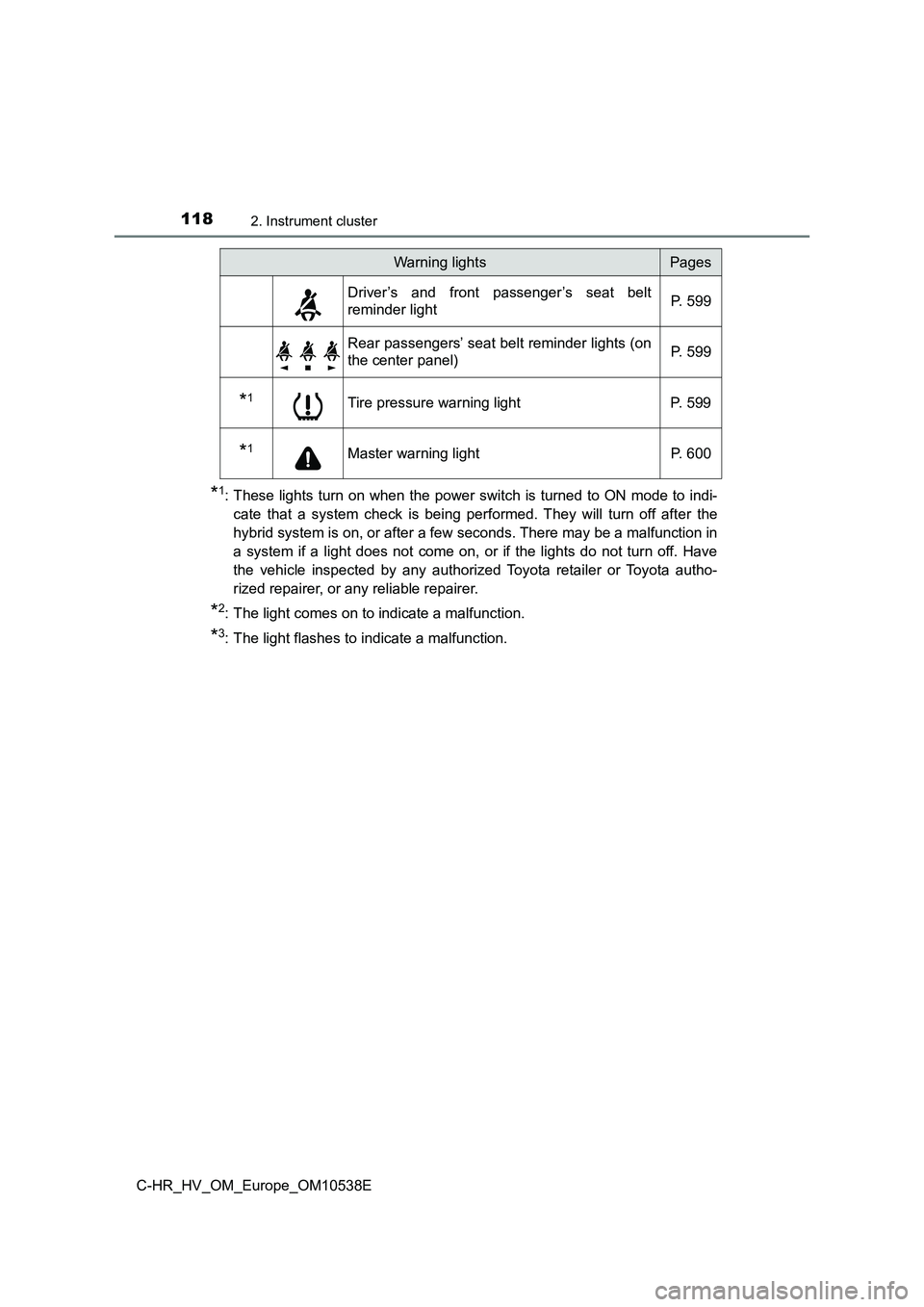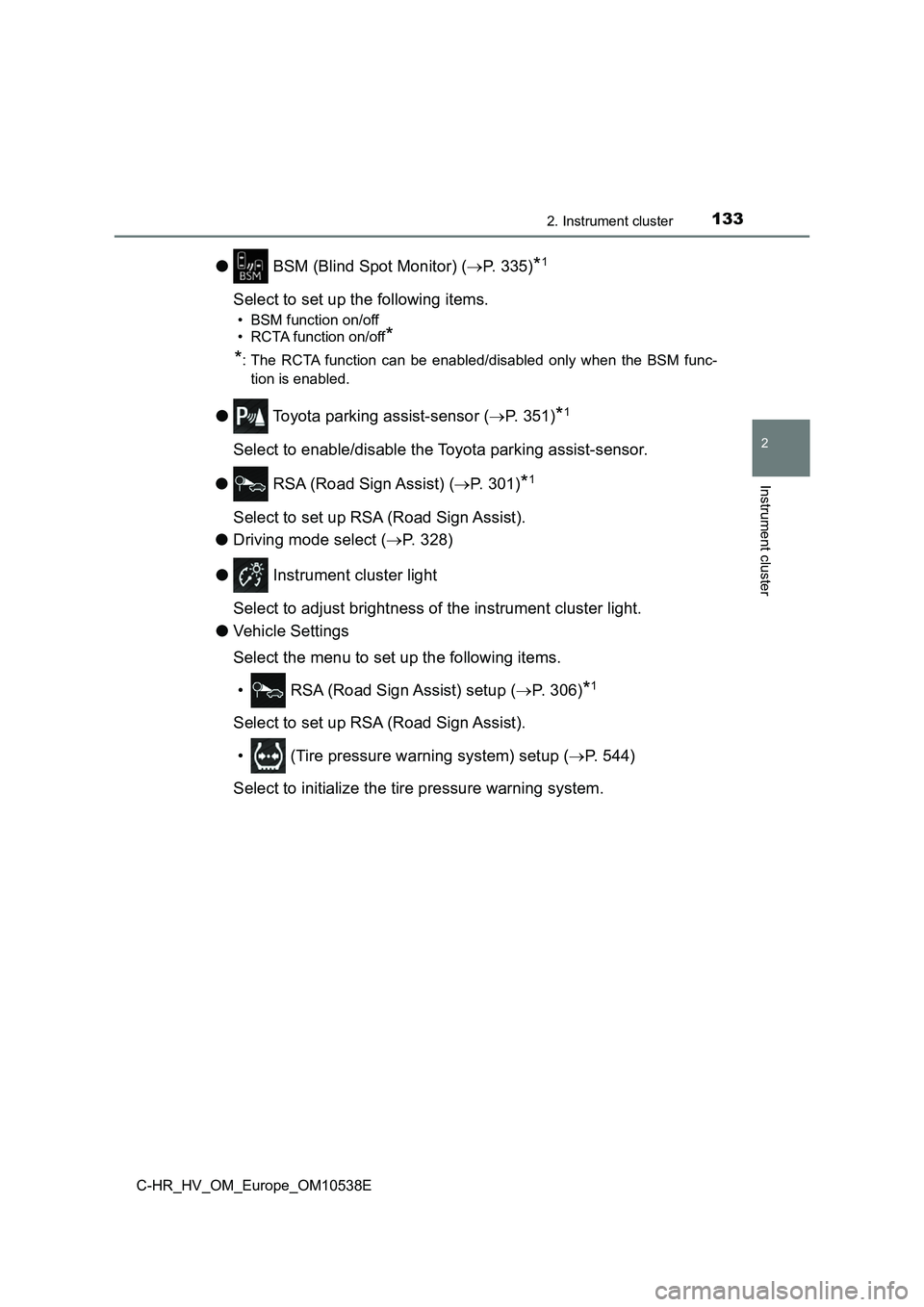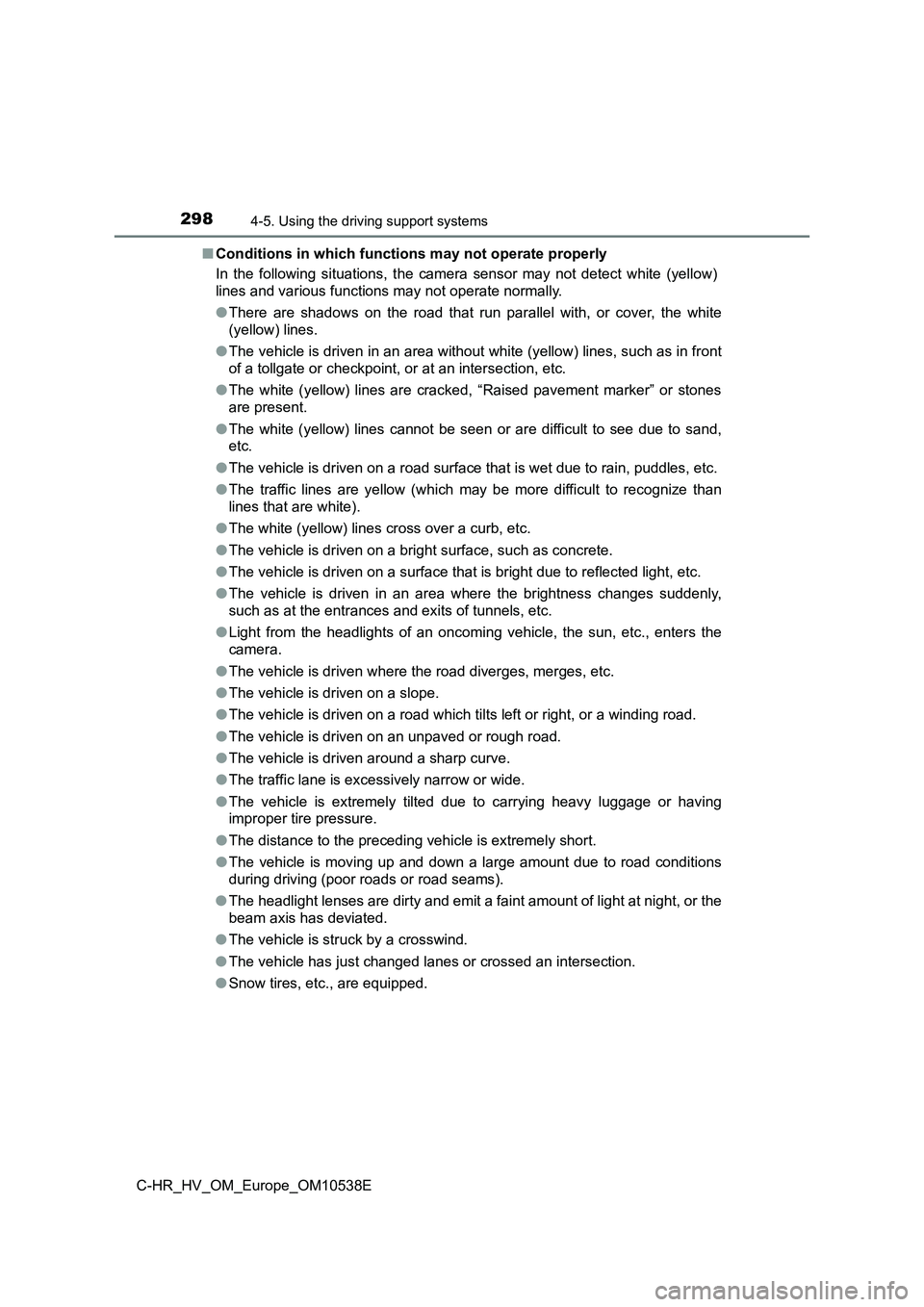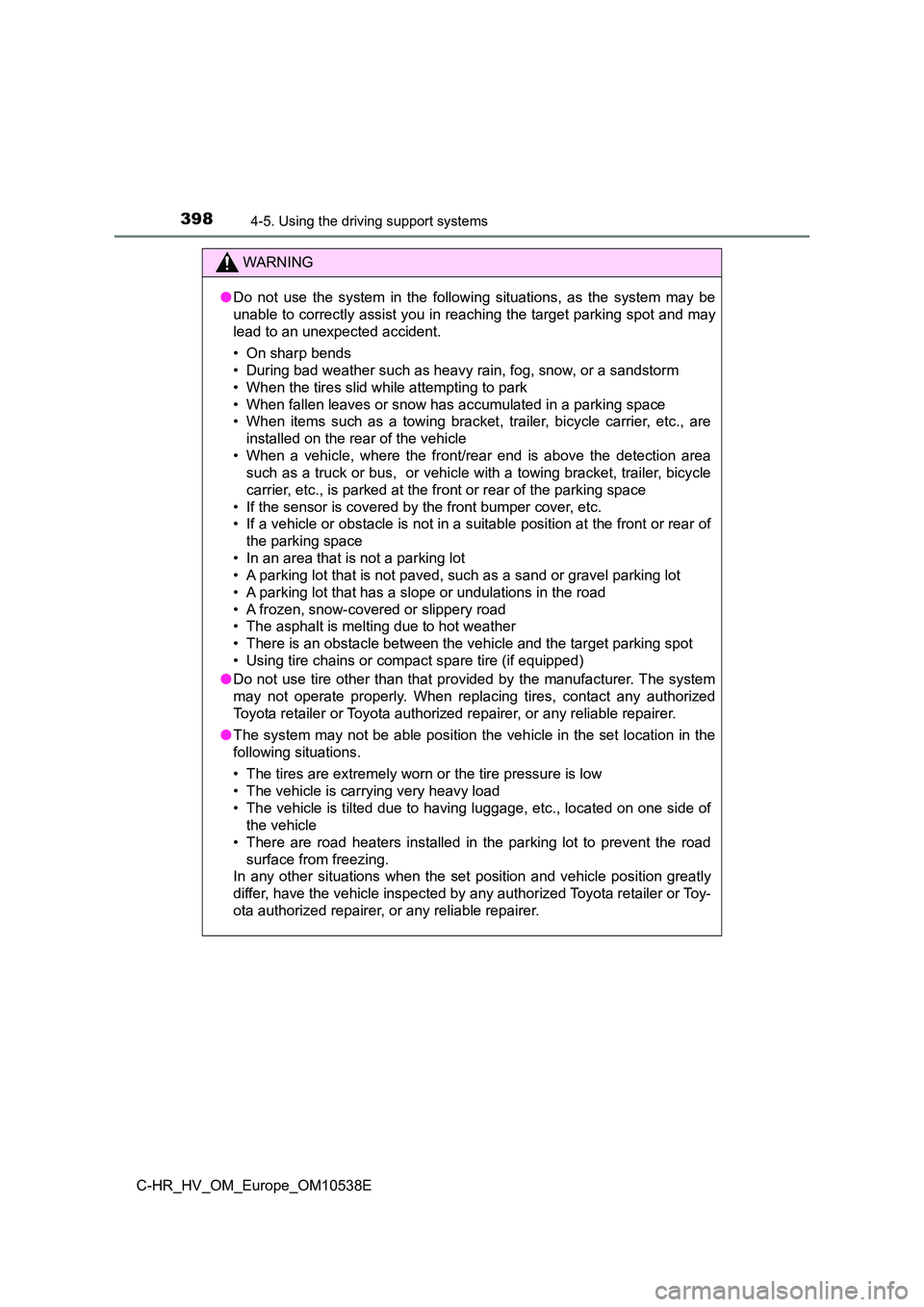tire pressure TOYOTA C_HR HYBRID 2017 Owners Manual
[x] Cancel search | Manufacturer: TOYOTA, Model Year: 2017, Model line: C_HR HYBRID, Model: TOYOTA C_HR HYBRID 2017Pages: 712, PDF Size: 49.31 MB
Page 6 of 712

TABLE OF CONTENTS6
C-HR_HV_OM_Europe_OM10538E
7-1. Maintenance and care
Cleaning and protecting
the vehicle exterior ..........512
Cleaning and protecting
the vehicle interior ...........517
7-2. Maintenance
Maintenance
requirements....................520
7-3. Do-it-yourself maintenance
Do-it-yourself service
precautions ......................523
Hood ..................................526
Positioning a floor jack .......528
Engine compartment..........529
Tires ...................................541
Tire inflation pressure ........553
Wheels ...............................555
Air conditioning filter ..........558
Electronic key battery ........561
Checking and replacing
fuses ................................564
Light bulbs .........................568
8-1. Essential information
Emergency flashers .......... 586
If your vehicle has to
be stopped in an
emergency ...................... 587
8-2. Steps to take in an
emergency
If your vehicle needs
to be towed ..................... 588
If you think something is
wrong .............................. 594
If a warning light turns
on or a warning buzzer
sounds ............................ 595
If a warning message
is displayed ..................... 606
If you have a flat tire
(vehicles with
an emergency tire
puncture repair kit) ......... 612
If you have a flat tire
(vehicles with
a spare tire) ..................... 632
If the hybrid system will
not start ........................... 646
If the electronic key does
not operate properly ........ 648
If the 12-volt battery is
discharged ...................... 651
If your vehicle
overheats ........................ 657
If the vehicle becomes
stuck................................ 662
7Maintenance and care8When trouble arises
Page 15 of 712

15Pictorial index
C-HR_HV_OM_Europe_OM10538EWindshield wipers . . . . . . . . . . . . . . . . . . . . . . . . . . . . . . . . . P. 256
Precautions for winter . . . . . . . . . . . . . . . . . . . . . . . . . . . . . . . P. 412
To prevent freezing (windshield wiper de-icer
*) . . . . . . . . . . . P. 482
Precautions for using a car wash . . . . . . . . . . . . . . . . . . . . . . P. 514
Fuel filler door . . . . . . . . . . . . . . . . . . . . . . . . . . . . . . . . . . . . P. 261
Refueling method . . . . . . . . . . . . . . . . . . . . . . . . . . . . . . . . . . P. 261
Fuel type/fuel tank capacity . . . . . . . . . . . . . . . . . . . . . . . . . . . P. 669
Tires . . . . . . . . . . . . . . . . . . . . . . . . . . . . . . . . . . . . . . . . . . . . P. 541
Tire size/inflation pressure . . . . . . . . . . . . . . . . . . . . . . . . . . . . P. 674
Winter tires/tire chains . . . . . . . . . . . . . . . . . . . . . . . . . . . . . . . P. 412
Checking/rotation/tire pressure warning system . . . . . . . . . . . P. 541
Coping with flat tires . . . . . . . . . . . . . . . . . . . . . . . . . . . . P. 612, 632
Hood . . . . . . . . . . . . . . . . . . . . . . . . . . . . . . . . . . . . . . . . . . . . P. 526
Opening . . . . . . . . . . . . . . . . . . . . . . . . . . . . . . . . . . . . . . . . . . P. 526
Engine oil . . . . . . . . . . . . . . . . . . . . . . . . . . . . . . . . . . . . . . . . . P. 670
Coping with overheating . . . . . . . . . . . . . . . . . . . . . . . . . . . . . P. 657
Headlights/front position lights/daytime running lights/
turn signal lights . . . . . . . . . . . . . . . . . . . . . . . . . . . . . . P. 235, 244
Front fog lights
* . . . . . . . . . . . . . . . . . . . . . . . . . . . . . . . . . . P. 254
Side turn signal lights . . . . . . . . . . . . . . . . . . . . . . . . . . . . . . P. 235
Stop lights/tail lights/turn signal lights . . . . . . . . . . . . P. 235, 244
Tail lights (LED type)
Back-up light
Shifting the shift lever to R. . . . . . . . . . . . . . . . . . . . . . . . . . . . P. 231
License plate lights . . . . . . . . . . . . . . . . . . . . . . . . . . . . . . . . P. 244
Rear fog light . . . . . . . . . . . . . . . . . . . . . . . . . . . . . . . . . . . . . P. 254
4
5
6
7
Light bulbs of the exterior lights for driving
(Replacing method: P. 568, Watts: P. 676)
*: If equipped
8
9
10
11
12
13
14
Page 118 of 712

1182. Instrument cluster
C-HR_HV_OM_Europe_OM10538E
*1: These lights turn on when the power switch is turned to ON mode to indi-
cate that a system check is being performed. They will turn off after the
hybrid system is on, or after a few seconds. There may be a malfunction in
a system if a light does not come on, or if the lights do not turn off. Have
the vehicle inspected by any authorized Toyota retailer or Toyota autho-
rized repairer, or any reliable repairer.
*2: The light comes on to indicate a malfunction.
*3: The light flashes to indicate a malfunction.
Driver’s and front passenger’s seat belt
reminder light P. 5 9 9
Rear passengers’ seat belt reminder lights (on
the center panel) P. 5 9 9
*1Tire pressure warning light P. 599
*1Master warning light P. 6 0 0
Warning lightsPages
Page 133 of 712

1332. Instrument cluster
2
Instrument cluster
C-HR_HV_OM_Europe_OM10538E
● BSM (Blind Spot Monitor) (P. 335)*1
Select to set up the following items.
• BSM function on/off
• RCTA function on/off*
*: The RCTA function can be enabled/disabled only when the BSM func-
tion is enabled.
● Toyota parking assist-sensor (P. 351)*1
Select to enable/disable the Toyota parking assist-sensor.
● RSA (Road Sign Assist) (P. 301)*1
Select to set up RSA (Road Sign Assist).
● Driving mode select (P. 328)
● Instrument cluster light
Select to adjust brightness of the instrument cluster light.
● Vehicle Settings
Select the menu to set up the following items.
• RSA (Road Sign Assist) setup ( P. 306)*1
Select to set up RSA (Road Sign Assist).
• (Tire pressure warning system) setup ( P. 544)
Select to initialize the tire pressure warning system.
Page 214 of 712

2144-1. Before driving
C-HR_HV_OM_Europe_OM10538E
■Information tag (manufacturer’s label)
Gross vehicle mass
The combined weight of the driver, passengers, luggage, towing hitch,
total curb mass and drawbar load should not exceed the gross vehicle
mass by more than 100 kg (220.5 lb.). Exceeding this weight is danger-
ous.
Maximum permissible rear axle capacity
The weight borne by the rear axle should not exceed the maximum per-
missible rear axle capacity by 15% or more. Exceeding this weight is
dangerous.
The values for towing capacity were derived from testing conducted at
sea level. Take note that engine output and towing capacity will be
reduced at high altitudes.
Ty pe AType B
WARNING
■ When the gross vehicle mass or maximum permissible axle capacity is
exceeded
Failing to observe this precaution may lead to an accident causing death or
serious injury.
● Add an additional 20.0 kPa (0.2 kgf/cm2 or bar, 3 psi) to the recommended
tire inflation pressure value. ( P. 674)
● Do not exceed the established speed limit for towing a trailer in built-up
areas or 100 km/h (62 mph), whichever is the lower.
1
2
Page 216 of 712

2164-1. Before driving
C-HR_HV_OM_Europe_OM10538E
■Tire information
● Increase the tire inflation pressure to 20.0 kPa (0.2 kgf/cm2 or bar, 3 psi)
greater than the recommended value when towing. ( P. 674)
● Increase the air pressure of the trailer tires in accordance with the total
trailer weight and according to the values recommended by the manufac-
turer of your trailer.
■ Tr a i l e r l i g h ts
Please consult at any authorized retailer or Toyota authorized repairer, or any
reliable repairer when installing trailer lights, as incorrect installation may
cause damage to the vehicle’s lights. Please take care to comply with your
state’s laws when installing trailer lights.
■ Break-in schedule
Toyota recommends that vehicles fitted with new power train components
should not be used for towing trailers for the first 800 km (500 miles).
■ Safety checks before towing
● Check that the maximum load limit for the towing hitch/bracket and hitch ball
is not exceeded. Bear in mind that the coupling weight of the trailer will add
to the load exerted on the vehicle. Also make sure that the total load exerted
on the vehicle is within the range of the weight limits. ( P. 213)
● Ensure that the trailer load is secure.
● Supplementary outside rear view mirrors should be added to the vehicle if
the traffic behind cannot be clearly seen with standard mirrors. Adjust the
extending arms of these mirrors on both sides of the vehicle so that they
always provide maximum visibility of the road behind.
■ Maintenance
● Maintenance must be performed more frequently when using the vehicle for
towing due to the greater weight burden placed on the vehicle compared to
normal driving.
● Retighten all bolts securing the hitching ball and bracket after towing for
approximately 1000 km (600 miles).
Page 287 of 712

2874-5. Using the driving support systems
4
Driving
C-HR_HV_OM_Europe_OM10538E
● In some situations such as the following, sufficient braking force may not be
obtained, preventing the system from performing properly:
• If the braking functions cannot operate to their full extent, such as when
the brake parts are extremely cold, extremely hot, or wet
• If the vehicle is not properly maintained (brakes or tires are excessively
worn, improper tire inflation pressure, etc.)
• When the vehicle is being driven on a gravel road or other slippery sur-
face
● Some pedestrians such as the following may not be detected by the radar
sensor and camera sensor, preventi ng the system from operating properly*:
• Pedestrians shorter than approximately 1 m (3.2 ft.) or taller than approx-
imately 2 m (6.5 ft.)
• Pedestrians wearing oversized clothing (a rain coat, long skirt, etc.), mak-
ing their silhouette obscure
• Pedestrians who are carrying large baggage, holding an umbrella, etc.,
hiding part of their body
• Pedestrians who are bending forward or squatting
• Pedestrians who are pushing a stroller, wheelchair, bicycle or other vehi-
cle
• Groups of pedestrians which are close together
• Pedestrians who are wearing wh ite and look extremely bright
• Pedestrians in the dark, such as at night or while in a tunnel
• Pedestrians whose clothing appears to be nearly the same color or
brightness as their surroundings
• Pedestrians near walls, fences, guardrails, or large objects
• Pedestrians who are on a metal object (manhole cover, steel plate, etc.)
on the road
• Pedestrians who are walking fast
• Pedestrians who are changing speed abruptly
• Pedestrians running out from behind a vehicle or a large object
• Pedestrians who are extremely close to the side of the vehicle (outside
rear view mirror, etc.)
*: Depending on the region in which the vehicle was sold, the pedestrian
detection function may not be available.
Page 298 of 712

2984-5. Using the driving support systems
C-HR_HV_OM_Europe_OM10538E
■ Conditions in which functions may not operate properly
In the following situations, the camera sensor may not detect white (yellow)
lines and various functions may not operate normally.
● There are shadows on the road that run parallel with, or cover, the white
(yellow) lines.
● The vehicle is driven in an area without white (yellow) lines, such as in front
of a tollgate or checkpoint, or at an intersection, etc.
● The white (yellow) lines are cracked, “Raised pavement marker” or stones
are present.
● The white (yellow) lines cannot be seen or are difficult to see due to sand,
etc.
● The vehicle is driven on a road surface that is wet due to rain, puddles, etc.
● The traffic lines are yellow (which may be more difficult to recognize than
lines that are white).
● The white (yellow) lines cross over a curb, etc.
● The vehicle is driven on a bright surface, such as concrete.
● The vehicle is driven on a surface that is bright due to reflected light, etc.
● The vehicle is driven in an area where the brightness changes suddenly,
such as at the entrances and exits of tunnels, etc.
● Light from the headlights of an oncoming vehicle, the sun, etc., enters the
camera.
● The vehicle is driven where the road diverges, merges, etc.
● The vehicle is driven on a slope.
● The vehicle is driven on a road which tilts left or right, or a winding road.
● The vehicle is driven on an unpaved or rough road.
● The vehicle is driven around a sharp curve.
● The traffic lane is excessively narrow or wide.
● The vehicle is extremely tilted due to carrying heavy luggage or having
improper tire pressure.
● The distance to the preceding vehicle is extremely short.
● The vehicle is moving up and down a large amount due to road conditions
during driving (poor r oads or road seams).
● The headlight lenses are dirty and emit a faint amount of light at night, or the
beam axis has deviated.
● The vehicle is struck by a crosswind.
● The vehicle has just changed lanes or crossed an intersection.
● Snow tires, etc., are equipped.
Page 398 of 712

3984-5. Using the driving support systems
C-HR_HV_OM_Europe_OM10538E
WARNING
●Do not use the system in the following situations, as the system may be
unable to correctly assist you in reaching the target parking spot and may
lead to an unexpected accident.
• On sharp bends
• During bad weather such as heavy rain, fog, snow, or a sandstorm
• When the tires slid while attempting to park
• When fallen leaves or snow has accumulated in a parking space
• When items such as a towing bracket, trailer, bicycle carrier, etc., are
installed on the rear of the vehicle
• When a vehicle, where the front/rear end is above the detection area
such as a truck or bus, or vehicle with a towing bracket, trailer, bicycle
carrier, etc., is parked at the front or rear of the parking space
• If the sensor is covered by the front bumper cover, etc.
• If a vehicle or obstacle is not in a suitable position at the front or rear of
the parking space
• In an area that is not a parking lot
• A parking lot that is not paved, such as a sand or gravel parking lot
• A parking lot that has a slope or undulations in the road
• A frozen, snow-covered or slippery road
• The asphalt is melting due to hot weather
• There is an obstacle between the vehicle and the target parking spot
• Using tire chains or compact spare tire (if equipped)
● Do not use tire other than that provided by the manufacturer. The system
may not operate properly. When replacing tires, contact any authorized
Toyota retailer or Toyota authorized repairer, or any reliable repairer.
● The system may not be able position the vehicle in the set location in the
following situations.
• The tires are extremely worn or the tire pressure is low
• The vehicle is carrying very heavy load
• The vehicle is tilted due to having luggage, etc., located on one side of
the vehicle
• There are road heaters installed in the parking lot to prevent the road
surface from freezing.
In any other situations when the set position and vehicle position greatly
differ, have the vehicle inspected by any authorized Toyota retailer or Toy-
ota authorized repairer, or any reliable repairer.
Page 408 of 712

4084-5. Using the driving support systems
C-HR_HV_OM_Europe_OM10538E
WARNING
■When the TRC/VSC systems are turned off
Be especially careful and drive at a speed appropriate to the road condi-
tions. As these are the systems to help ensure vehicle stability and driving
force, do not turn the TRC/VSC systems off unless necessary.
■ Replacing tires
Make sure that all tires are of the specified size, brand, tread pattern and
total load capacity. In addition, make sure that the tires are inflated to the
recommended tire inflation pressure level.
The ABS, TRC and VSC systems will not function correctly if different tires
are installed on the vehicle.
Contact any authorized Toyota retailer or Toyota authorized repairer, or any
reliable repairer for further information when replacing tires or wheels.
■ Handling of tires and the suspension
Using tires with any kind of problem or modifying the suspension will affect
the driving assist systems, and may cause a system to malfunction.